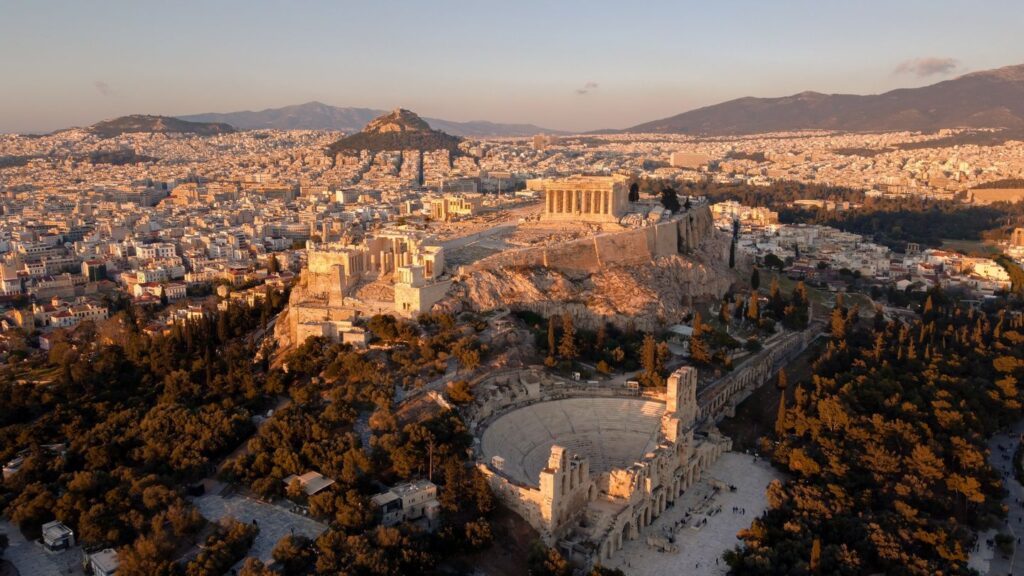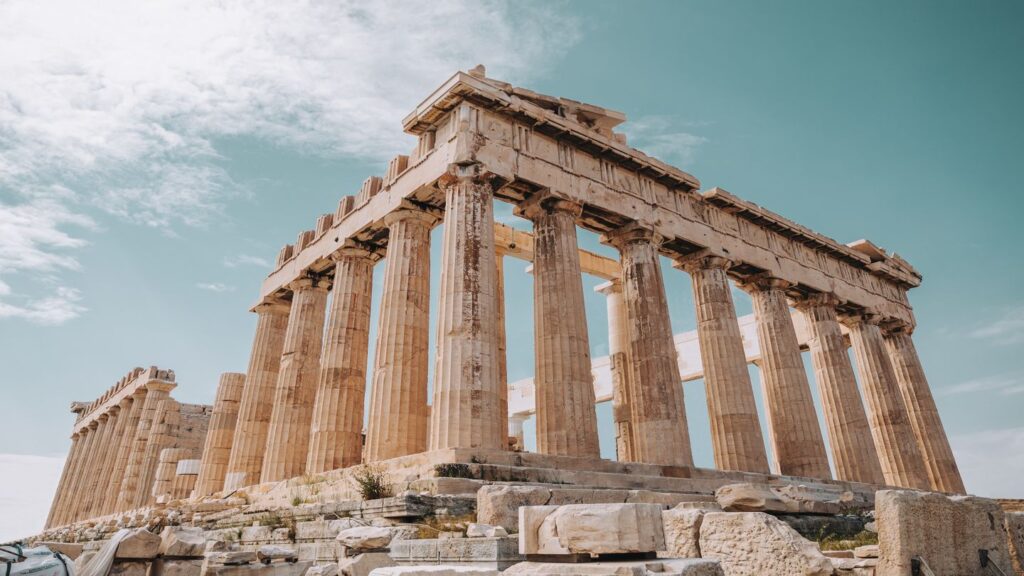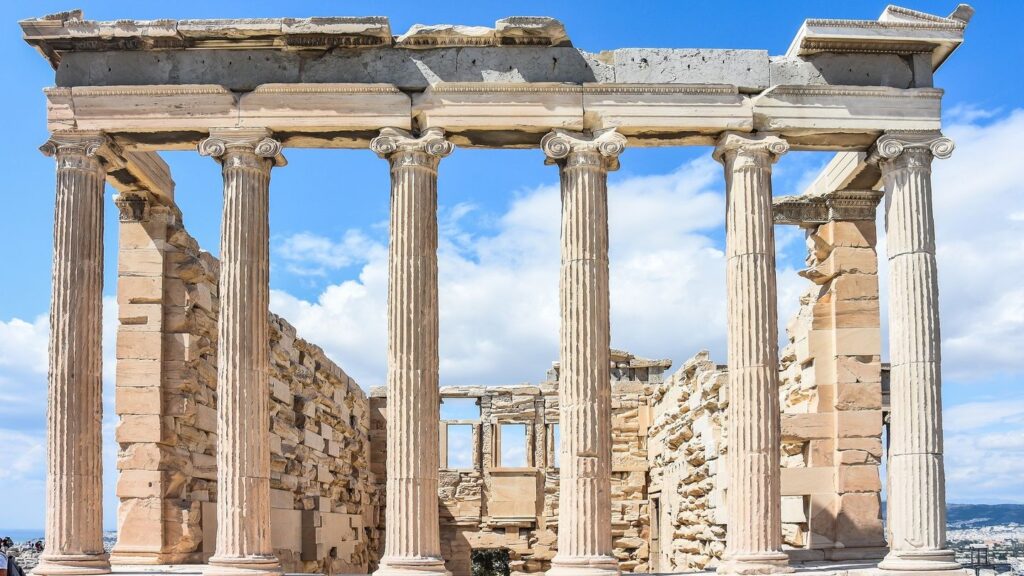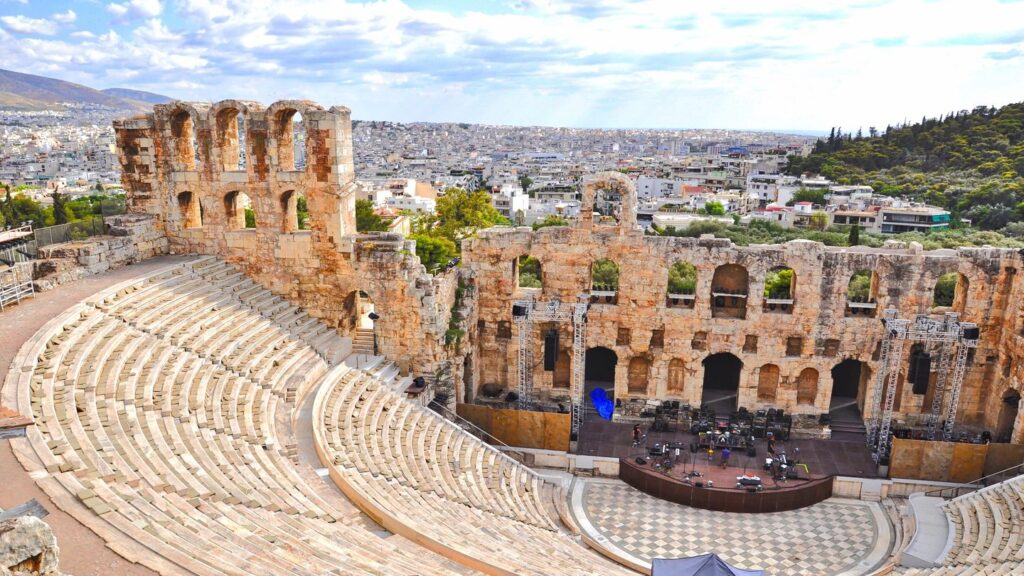Set high above the city of Athens on a rocky hill, the Acropolis is an icon of Greece. The ancient complex is made up of famous structures like the Parthenon and is renowned as one of the finest surviving examples of Greek architecture. With a timeline dating back thousands of years, the history of the Acropolis in Athens is overflowing with stories of war, empires, destruction, and reconstruction. Ready to dive into the history of the Acropolis? Here are 9 fascinating facts about the Acropolis of Athens in Greece.
WATCH: Discover the Hidden Gems of Athens – Join Trafalgar Local Specialist Konstantinos as he takes you on a tour of Athens’ hidden gems.
You can discover more of the best of your favourite destinations with locals who know it best when you watch the Unlocked Series on Youtube.
1. The Acropolis’ human history dates back thousands of years
An Acropolis is a city or complex built on a high hill. While there are many acropoleis throughout Greece, the one in Athens is the most famous – and one of the oldest! The Acropolis is located on the Attica plateau and it was first inhabited sometime around the 4th millennium, making it one of the earliest known settlements in all of Greece.
There’s evidence of humans inhabiting the area all the way back in the Neolithic period between 4000-3200 BCE, with a grave, a house, and several shafts and vessels found from this era. Human bones were also found among the shafts, and there’s a theory that the shafts were once the site of ritual burials. They could have also been wells as there are natural springs on the limestone slopes of the hill where the Acropolis stands.
GET INSPIRED BY: Best of Greece


2. The Acropolis’ most famous structures were built in just a few decades
One of the most impressive facts about the Acropolis in Athens is that its most famous structures – the Parthenon, the Temple of Athena Nike, the Propylaea gate, and the Erechtheion temple – were all built in just a few decades in the 5th century BCE. The Parthenon alone was built between 447 and 432 BC and its intricate structure is astonishing.
The statesman Pericles launched the construction of the Acropolis when the Athenian Empire was at its most powerful. He intended it as a centre for Greek art, thought and faith. The huge project was led by architects Ictinus and Callicrates and the sculptor Phidias, and it required the effort of thousands of labourers, engineers, and artists.
They completed the whole collection of buildings in just 50 years. This is particularly impressive considering they brought the famous white marble from a quarry located 16 kilometres to the northeast of Athens all the way up the steep slopes of the Acropolis.
RELATED CONTENT: Our guide to Greece: everything you need to know


3. The Acropolis has survived a lot of war and destruction
The Acropolis in Athens is the most intact surviving ancient Greek complex… and that’s incredible considering the centuries of war, natural disasters, reconstruction, and changes.
While the Acropolis was built in the golden age of the Athenian Empire, this era was brief. Athens battled Sparta in the Peloponnesian War soon after they finished the Parthenon, with the Spartans seizing Athens in 404 BCE.
The Ottoman Empire then invaded Greece in 1453, ending the reign of the Byzantine Empire. The Ottoman Turks controlled Greece for almost 400 years… But in 1687, a Venetian army attacked the Parthenon with heavy mortar shells, as the Ottomans were storing gunpowder there.
The Parthenon was damaged but remained largely intact until 1801 when Lord Elgin, an ambassador from the UK, struck a deal with the Ottomans. This deal led to Elgin taking the Parthenon marble sculptures adorning the structure. The majority of the Parthenon Sculptures are now in the British Museum of London. While Greece has demanded the return of the sculptures, the UK has not yet returned them.
The Greeks did not take back control of the Acropolis until 1822 during the Greek War of Independence.
GET INSPIRED BY: Secrets of Greece including Corfu


4. The Acropolis’ history includes a defensive wall, a church and a mosque
While the Acropolis we see today was built as a centre for art, thought, and faith, the area has had many different uses over the years. Thanks to its high, central position above Athens, it was useful as a military defence point. The ancient Mycenaeans built the first defensive wall in the 13th century BCE, used for around eight centuries. You can still see remnants of the wall today.
The Roman Emperor Augustus built a temple around 19 BC, while the Roman Emperor Claudius built a large marble stairway to the Propylaea sometime during his reign from 41-54 AD. The Ottoman Empire also built some small houses around the Acropolis.
The Acropolis also has a rich religious history. The first pagan temples at the site date back to the 6th century BCE. The Parthenon became a church dedicated to Panagia (Virgin Mary), then became known as the Church of the Parthenos Maria.
During the 7th century CE, the Byzantines converted the Parthenon into a cathedral. But it was reborn again into a Catholic cathedral by the Franks in 1204. By the 15th century, the Ottoman Empire again converted the Parthenon into a Muslim mosque, adding a minaret on the southwest corner.
RELATED CONTENT: 14 fun facts about Greece you never knew


5. The Parthenon is famed as “the world’s most perfect building”
The Parthenon was built nine centuries ago as a sacred temple for the goddess Athena, and it’s still considered an architectural marvel. The structure has architectural tricks like the slight angling of the pedestal to correct the optical illusion that the building sinks in the middle. There are also curves on the columns to correct the illusion that they get smaller in the middle. With a few deliberate imperfections, the architects ingeniously built the perfect building!
GET INSPIRED BY: Best of Greece with Island Hopper
6. A giant statue of Athena once stood over the Acropolis
While the Acropolis remains remarkably intact, many amazing structures were lost over the centuries. One of the most fascinating facts about the Acropolis in Athens is that a colossal statue of Athena, known as Athena Parthenos, once stood inside the Parthenon. The statue was around 9-12 metres high and made by the sculptor Phidias from ivory and gold. It was covered in armour and jewellery and the statue held a shield and spear in her hands. Athena symbolised the strength of the Athenians over the Persians in their war.
While the statue was stolen and destroyed sometime between 284 AD and 700 AD, you can still find replicas of the Athena Parthenos. Head to Nashville, Tennessee, and you can set eyes on a full-sized reconstruction of the Parthenon, including the Athena Parthenos. The artist Alan LeQuire created this masterpiece in the 1980s.
RELATED CONTENT: Greek phrases you should learn before your next trip to Greece


7. The Acropolis is home to the world’s oldest weather station
Set on the slopes of the Acropolis, the Tower of the Winds is the world’s oldest weather station. It’s an octagonal marble structure dating back 2,000 years, and once had a bronze wind vane above the sundial. Some historians theorise the weather station had a water clock powered by water flowing down the steep hill, so Athenians could tell the time at night. Amazing!
RELATED CONTENT: Seeking Out the Ancient Temples of Greece
8. The Acropolis was once painted
When you picture the Parthenon and the Acropolis, you probably picture gleaming white marble. But one of the most interesting facts about the Acropolis in Athens is that it was once painted in colour. Recent laser cleaning of the Parthenon revealed ancient paint in shades of red, blue, green and even bronze. Over the centuries, the sun rays bleached the stones white again.
RELATED CONTENT: Discover the best of Greece


9. The Acropolis was a site of Greek resistance to fascism
After Nazi Germany and Fascist Italy invaded Greece in April 1941, they raised a German flag with a Nazi swastika over the Acropolis. On the night of May 30 1941, two Greek men who were part of the Greek Resistance movement – Manolis Glezos and Apostolos Santas – climbed up the hill to the Acropolis. They pulled down the German flag and slashed it as a defiant act against fascism and the German occupation.
The Greek flag now flies over the Acropolis. You can watch the Greek Presidential Guard, the Evzones, perform flag-raising and flag-lowering ceremonies at dawn and dusk on Sundays.
Do you know any interesting facts about the history of the facts about the Acropolis of Athens? Let us know in the comments below!